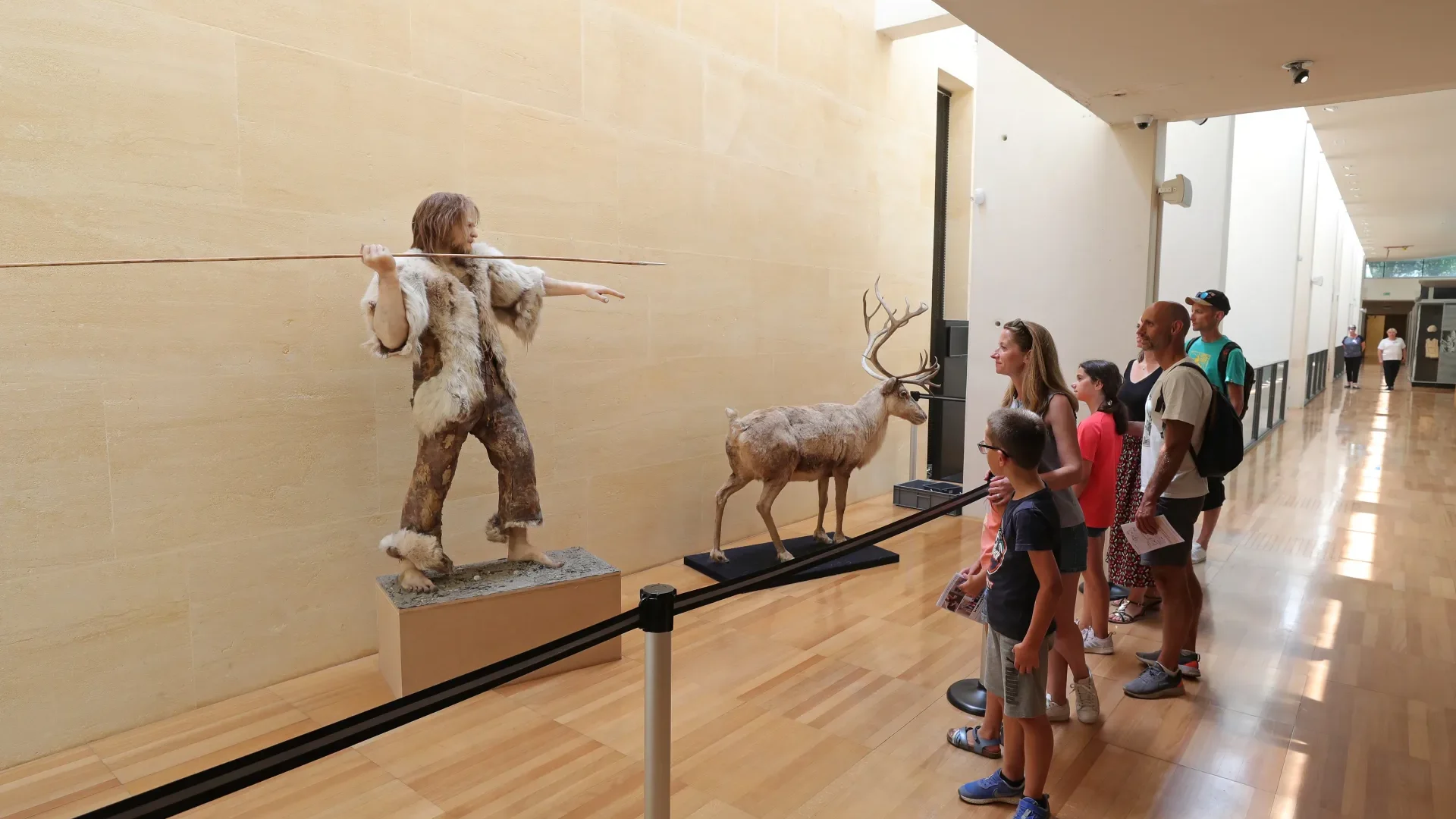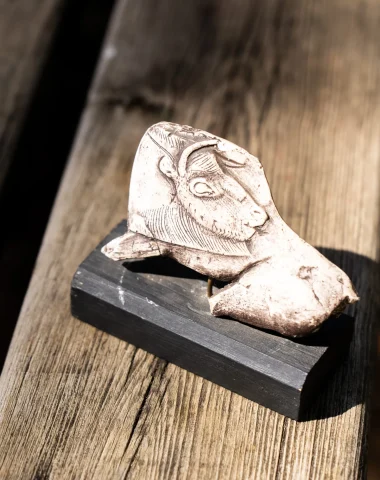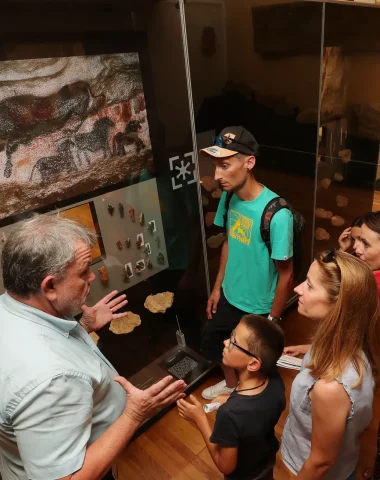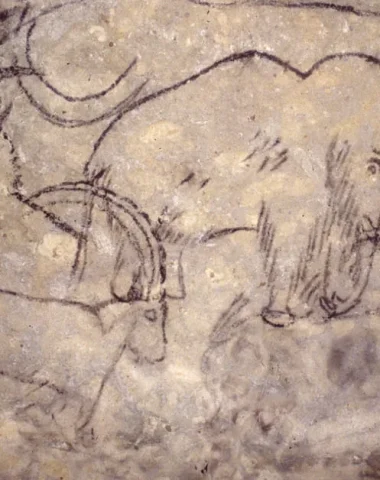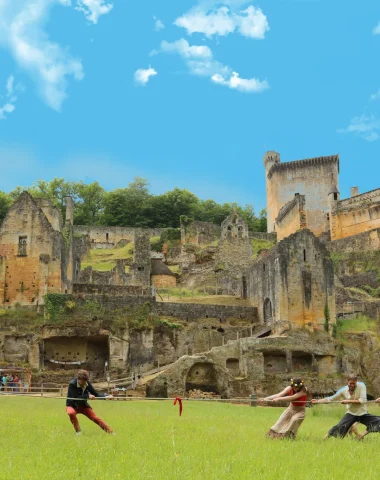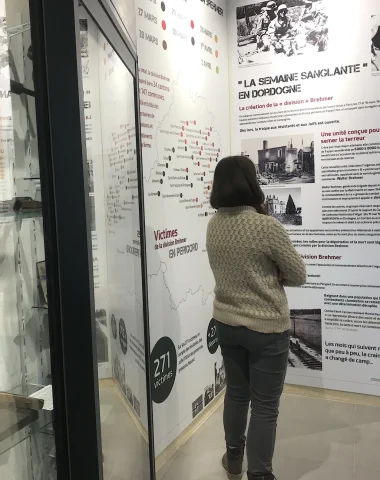Known worldwide for the richness and density of its prehistoric sites, the Black Périgord is one of the first cradles of knowledge of human evolution. In the only Vézère valleyInter Montignac-Lascaux et Les Eyzies, there are more than 200 Paleolithic sites, including the famous decorated caves listed as UNESCO World Heritage.
The Vézère valley in Périgord Noir, the valley of Prehistory
Prehistory begins in Dordogne, in the Vézère valley, about 400 years ago, with the arrival of Homo erectus, originating from the African continent (like all hominids). From him, we find evidence of an already advanced technology, such as his bifaces in flint and the use of fire, a sign of adaptation to the cold environment of the glaciations which marked Europe.
Neanderthal and Cro Magnon in the Vézère valley
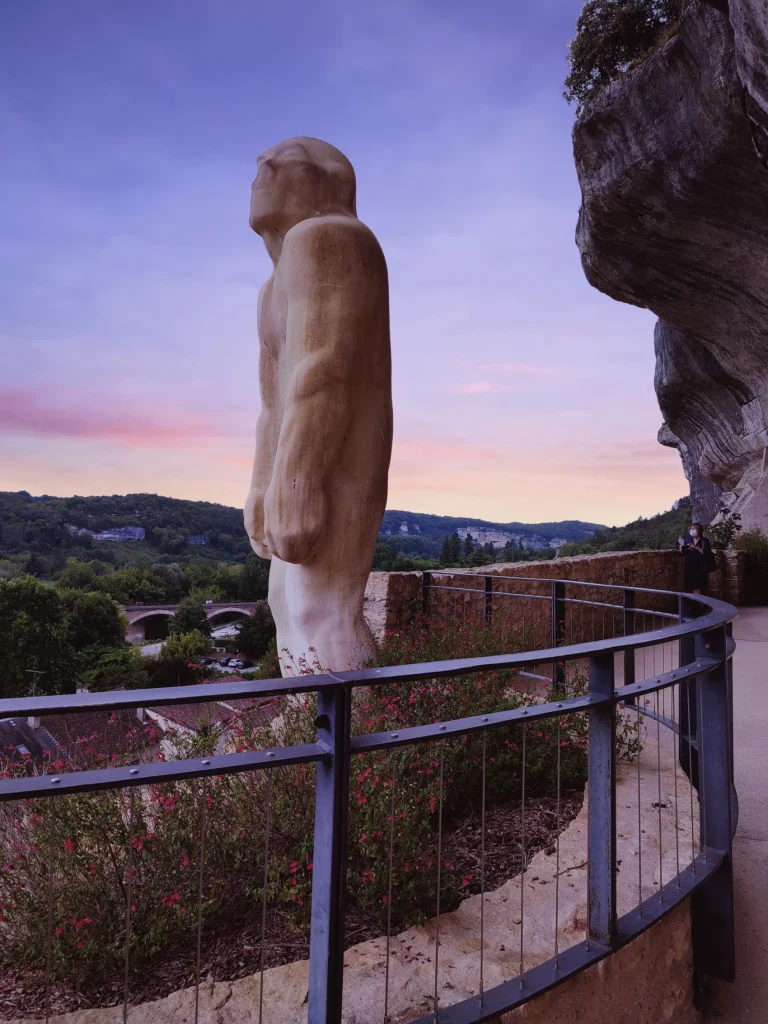
Neanderthals in the caves of the Vézère valley
After Homo Erectus, it is Neanderthal, the species which preceded and coexisted with Homo Sapiens, which evolved in Dordogne and more precisely in Vézère valley. He leaves us abundant remains of its tools and game which it hunted until its disappearance around 30 years ago. He is the first human ancestor to bury his dead as evidenced by the burials of La Ferrassie and Moustier, attesting to spiritual and symbolic concerns.
We know today that Neanderthal was not the thick brute described at the beginning of the 300th century. An outstanding hunter, he was able to adapt to all the climatic changes in Europe for at least 000 years, sometimes during long and difficult glacial periods. We also know thanks to paleonto-genetics that crosses with Sapiens took place over a period of coexistence of approximately 10 years. That is why the modern man today has in its genetic heritage, between 1% and 4% of Neanderthal genes. Theories about his disappearance evolve, but none to date have definitively demonstrated the causes of his disappearance.
Sapiens
But it is our direct ancestor, Homo sapiens sapiens or Cro-Magnon, arrived in the Vézère valley 35 years ago, that we owe the remarkable abundance of artistic and symbolic expression. The latter is manifested through the abundance of ornaments (pearls, pierced teeth, bracelets), sculptures and engravings on bone and stone, and by the magnificent caves and ornate shelters what are Lascaux, Font-de-Gaume, Combarelles, cap blanc, Castel Merle, Bara-Bahau and many others. He is also the author of numerous technical innovations in the working of stone, bone, reindeer antler and mammoth ivory which allowed him to invent new tools such as the eye needle and the propellant.
All these ancestors were nomadic hunter-gatherers, living from the direct exploitation of nature. Let us remember that man has only been a sedentary farmer for 10 years and that this first way of life therefore covers 000% of human history...
The Lascaux cave
The original Lascaux cave was closed to visitors in 1963 by the Minister of Culture André Malraux. In 15 years of tourist exploitation, the 1,5 million visitors have irreparably damaged the paintings that were until then protected. We must therefore wait for the first facsimile to be produced, Lascaux II, by the painter Monique Peytral, to see Lascaux open to the public again.
Today, the International Center for Cave Art Lascaux IV has been offered in the town of Montignac-Lascaux since 2016.
Caves, meat, fresh water, the cocktail of prehistoric success?
But why are there so many prehistoric remains in Vézère valley and in Dordogne? We could say that our ancestors were attracted by favorable conditions, offering essential resources: game, fish, flint for making tools. But didn't these conditions exist elsewhere?
No doubt, but we must face the facts that human occupation, from Homo Erectus to Sapiens via Neanderthal, is 400 years in remarkable continuity, whatever the climatic periods and types of resources.
The abundance of remains in Périgord can also be explained by other factors. First of all, by the exceptional conservation of remains in caves and rock shelters where the limestone rock protected them from natural or human destructive elements.
Finally, the large number of known sites in Dordogne is also the result of a long history of research and protection. For more than a century and a half, excavations and studies have contributed to our knowledge almost uninterruptedly; it is here that the first prehistorians established a chronology which is still considered a world reference today. La Micoque, Moustier, La Madeleine are the sites, known throughout the world by lovers of Prehistory, which gave their name to the great cultures of Prehistory.
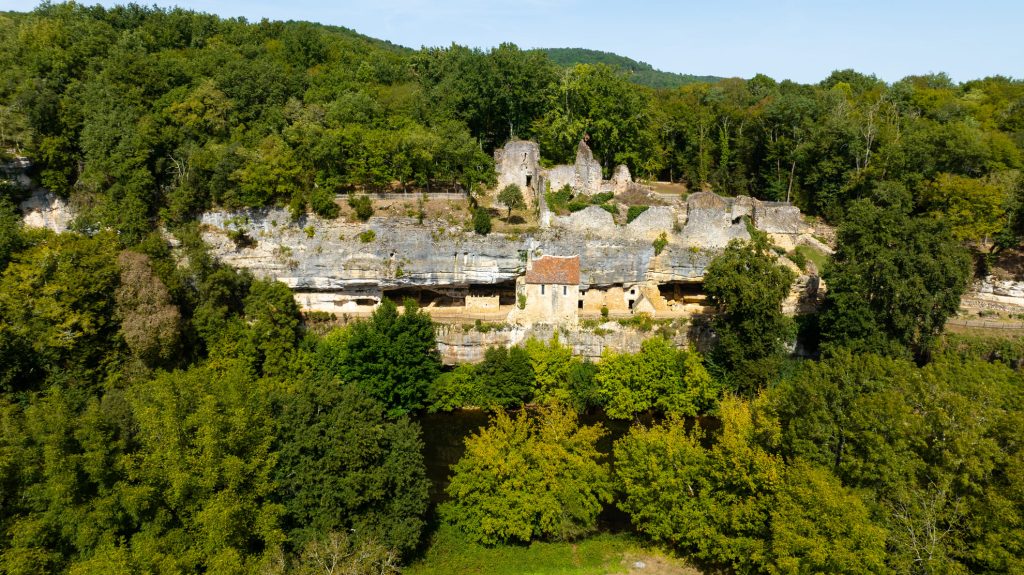
And this search continues... Today, the Black Périgord, especially with the Regourdou website still plays a key role in the major questions posed to us by the history of humanity such as the disappearance of Neanderthals, its relationship with our ancestor, Homo sapiens sapiens, the appearance of art, and so many others.
With numerous sites open to the public, such as the National Museum of Prehistory, with conferences and educational activities proposed, amateurs and tourists are invited to participate in this great quest for human origins.
Caves and rock shelters to visit
We can feel a little lost in all the existing sites, their eras and what characterizes them. You will be able to see all the sites present in the Vézère valley at a glance.
Please note, not all of them are open to visitors as is the case for the La Mouthe or La Madeleine deposits (even if the troglodyte village can be visited).
| name of the site | Site type | Dating | Gender and culture |
| La Micoque | Deposit | 450 years | Homo erectus (Micoquian) |
| Castel Merle | Deposit | between 30 and 000 years ago | Neanderthals and Sapiens |
| La Ferrassie | Rock shelter | 50 years | Neanderthal |
| Le Regourdou | Deposit | 70 years | Neanderthal |
| Le Moustier Holiday Rentals | Deposit | between 56 and 000 years ago | Neanderthal (Mousterian) |
| Abri Pataud | Rock shelter | between 35 and 25 years ago | Sapiens (Aurignacian and Solutrean) |
| The Mouthe | Deposit | between 30 and 000 years ago | Sapiens (Mousterian and Magdalenian) |
| Cro-Magnon shelter | Rock shelter | 27 years | Neanderthal (Mousterian) |
| The Fish Shelter | Rock shelter | 25 years | Sapiens, (Gravettian) |
| Laugerie-Haute | Rock shelter | 24 to 14 years | Sapiens, (Gravettian to Magdalenian) |
| Lascaux cave | Reenactment | 18 years | Sapiens, (Magdalenian) |
| La Madeleine | Rock shelter | 15 years | Sapiens, (Magdalenian) |
| Bara Bahau Cave | Reenactment | 15 years | Sapiens, (Magdalenian) |
| cap blanc | Reenactment | 15 years | Sapiens, (Magdalenian) |
| Font-de-Gaume | Caves | 14 years | Sapiens, (Magdalenian) |
| Laugerie-Basse | Reenactment | 15 to 10 years | Sapiens, (Magdalenian) |
| The Sorcerer's Cave | Caves | 17 to 14 years | Sapiens, (Magdalenian) |
| Bernifal Cave | Caves | 14 to 12 years | Sapiens, (Magdalenian) |
| The Combarelles cave | Caves | 13 years | Sapiens, (Magdalenian) |
| The Rouffignac cave | Caves | 13 years | Sapiens, (Magdalenian) |
Les Eyzies, world capital of Prehistory
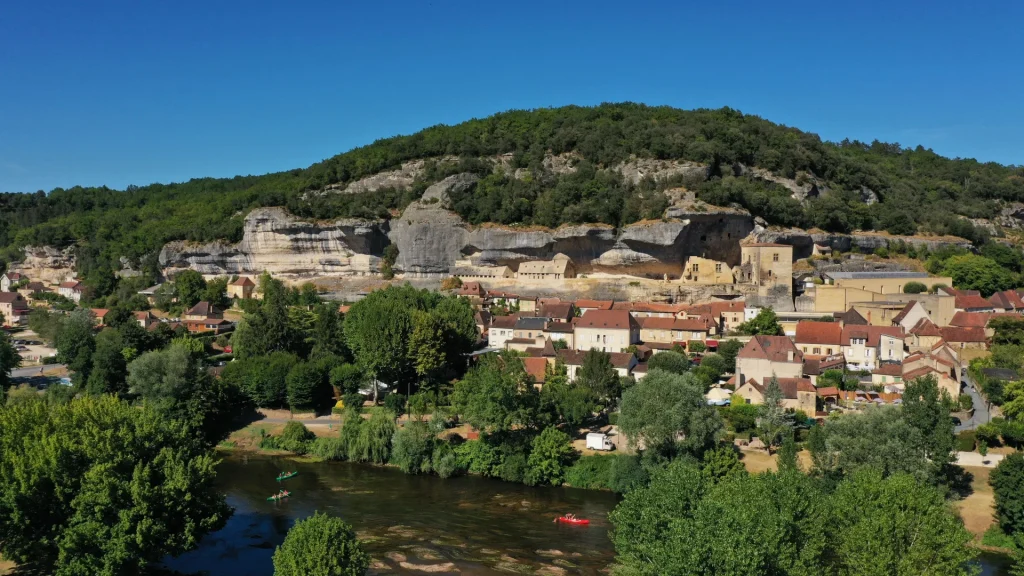
If there is a singular place, it is good the village of Eyzies. In this small area (on a geographical scale), group together an extraordinary quantity of prehistoric sites of all kinds and from all periods of the Paleolithic. You can find there jumbled together:
- Font de Gaume Cave
- Combarelles Cave
- Fish Shelter
- Cap-Blanc shelter
- Micoque shelter
- Shelter Laugerie Basse
- Abri Laugerie Haute
- Abri Pataud
- Cro-Magnon shelter
Since the start of the various excavations, we have found more than 18 objects spread across the different prehistoric sites ! It was natural that in 1918 it was established there the National Museum of Prehistory (with its famous primitive man from 1931 by Paul Dardé) before the International Prehistory Center was created in 2002, later renamed Prehistory Interpretation Center.
We are here to help you !
We know from experience that it is not always easy to find your way with all these sites, how to book, for what, where, etc. The entire team at the Lascaux-Dordogne tourist office is at your disposal to help and inform you in order to fully succeed in your stay in the great cradle of the History of Humanity.. Do not hesitate to contact us, we are here for you!
